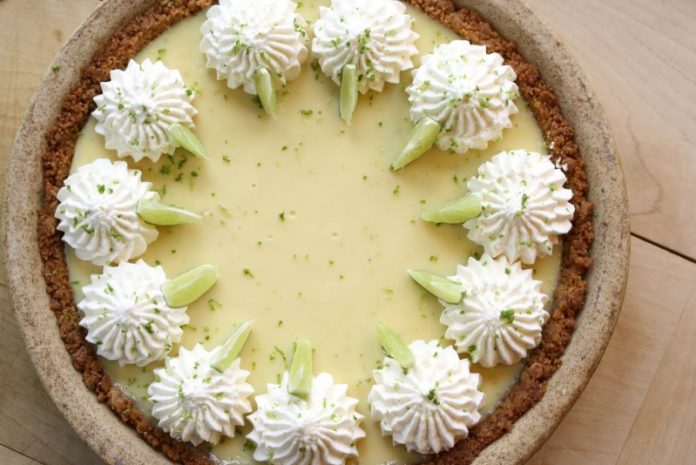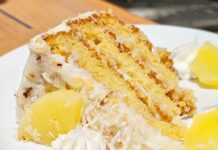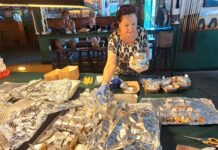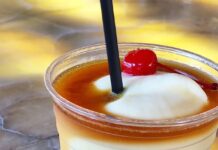Arguments erupt and ALL CAPS fill the comment sections of social media when someone dares to ask if a pastry crust or a Graham cracker crust should cradle a real slice of a Key lime pie. The emotional responses are largely personal, and while passion is part of what makes Key West’s native dessert so revered, the “Because that’s how Nana did it!” response fails to acknowledge the fascinating history that led to the great crust debates of the 21st century. Let’s venture back into the Key Lime Pie Hole and consider the untold evolution of Key lime pie crust.
Key lime pie started her journey some time after sweetened condensed milk arrived on the scene in 1856. Pastry crust has existed since at least 1545, but historians believe the earliest Key lime pie was more pudding than pie. Key West’s sponge fishermen are credited with creating the dessert by mixing sweetened condensed milk, lime juice and stale bread or crackers. The passage of time prevents these fishermen from chiming in on the “original crust” argument, but it is safe to assume they were not baking pastry pie shells on the sponge skiffs. This addition was saved for landlubbers.
The first known published Key lime pie recipes came out in the 1930s. The earliest called for a Graham cracker crust, but other recipes from the ’30s called for “crumb or pastry crust according to preference.” These recipes suggest that all crusts are created equal, but basing an argument on published recipes discounts spoken word, family tradition and undated recipe cards, all of which play an important role in the story of Key lime pie. Talk to any Key West native who grew up enjoying lime pie prepared with a pre-1930s family recipe and it will become crystal clear that a pastry crust was the original Key lime crust on the island. Story after story confirms it. But, with time, that exclusivity would vanish.
1928 marked a major turning point in the evolution of Key lime pie. Monroe Boston Strauss, the world’s leading pie expert, was looking for a crust that would “eliminate soaking and assure a crisp, well-baked crust for custard pies.“ He invented a rolled-in Graham cracker crust as a solution. The Overseas Highway opened the same year, followed by roadside diners serving local flavors to the new wave of travelers seeking a taste of the tropics. Turtle steaks and Key lime pie became favorites, but commercial Key lime pie preparation presented challenges home cooks never considered, and the Graham cracker crusts offered solutions. Time is money, and Graham cracker crusts took less time to prepare. They also stored longer than pastry crusts and didn’t get soggy under the moisture of the wet custard. On top of that, customers loved the taste. This combination of ease, economics, and customer satisfaction made Graham crackers the pie base of choice in our island restaurants, and soon there was a new King of Crusts in the Florida Keys.
A lot of the “old-timers” in Key West today are transplants who arrived after 1928. Most of them had their first taste of Key lime pie in a cafe along the Overseas Highway. A sweet Graham cracker crust is locked into their mind as the first and the original and, to them, that will always be the way a real Key lime pie should be prepared. Conch families with several generations under their belts hold proudly to their heritage and know the only real Key lime pie has a light, flakey pastry crust. In a sense, both sides are right, as those are the real versions to them. But the fact is that a tourist today would be hard-pressed to find a slice of Key lime pie served with a pastry crust in a Florida Keys restaurant. They’ll probably never experience a pastry crust, never compare the two crusts in a taste test, and many will never even know pastry crust is an option — the original one at that. In the Key lime world, the Graham cracker crust shows no sign of giving up her crown.
It’s part of the evolution most foods experience, but somewhere along the way, crust discussions devolved into the expectation that our own preference should dictate how a pie is served or the degree to which others enjoy it. Food is deeply personal, but something as special as Key lime pie should bring people together instead of pushing them apart.
The next evolution of Key lime pie is happening now. Crusts prepared with cookies, nuts, cereals and pretzels are popping up around town and setting a standard for first-time visitors and future generations. One day someone may argue that bacon is the original crust, but we’ll be armed with the facts. Pastry crusts came first; Graham cracker crusts were the innovation. But in the end, there is really no wrong way to prepare a Key lime pie. Perhaps now we can stop arguing and get back to the important question: Should real Key lime pie be topped with whipped cream or meringue?
Love & Limes
Pastry Crust Tips & Tricks
- Resist premade frozen crusts. There is no reason to be intimidated by
pastry crusts.
- Refrigerate all of your ingredients first, even the flour and salt.
- Use a mixture of cake flour and all-purpose flour for the best crust.
Too much cake flour will make the crust delicate. Too much all-purpose flour will make it tough.
- Always combine dry ingredients first.
- Butter should be quite cold. If it starts to soften, chill it before continuing.
- For a flakier pie, substitute half of the butter for shortening.
- Mix until dry ingredients combine with butter to form very small pea shapes before addig water.
- Pockets of fat create flaky layers. Use two knives to cut butter into the pastry and allow some of the pea-sized portions to remain.
- The addition of ice water should bind the peas into a single pastry ball.
- Substitute sour cream for water to create a flakier crust.
- Substitute egg for water to create a well-bound, durable crust.
- When rolling dough, lift periodically to prevent sticking. Flour dust your rolling surface and rolling pin.
- Roll dough around rolling pin to transfer to the pie pan without damaging it.
- Brush your crust with egg whites and refrigerate for 20 minutes before baking to add extra protection from a soggy crust.
- Spice up your pastry crust with some of the items on the secret ingredient page. Cinnamon, nutmeg, and most dry spices work well. So do crushed nuts, cookies and cereals.
Classic Pastry Crust
- Easy to make.
- Serves: 8
Ingredients
1 ¼ cups all purpose flour
1 tablespoon white sugar
1/8 teaspoon salt
8 tablespoons unsalted butter, chilled
3 tablespoons ice water
Directions
- Combine flour, sugar and salt in a medium bowl.
- Divide butter into 8 slices. Work into dry ingredients with fingers until pea sized balls form.
- Add ice water and mix with fork. Form into flat disk, wrap in plastic and refrigerate 45 minutes.
- Preheat oven to 425°F
- Roll dough to 12” diameter and lay in 9” pie pan. Trim edges.
- Bake at 425°F for 15-20 minutes. Let cool before filling.
The classic crust is actually the flaky pastry crust, now rarely observed in the wilds of Key West. BAKING BITES


























